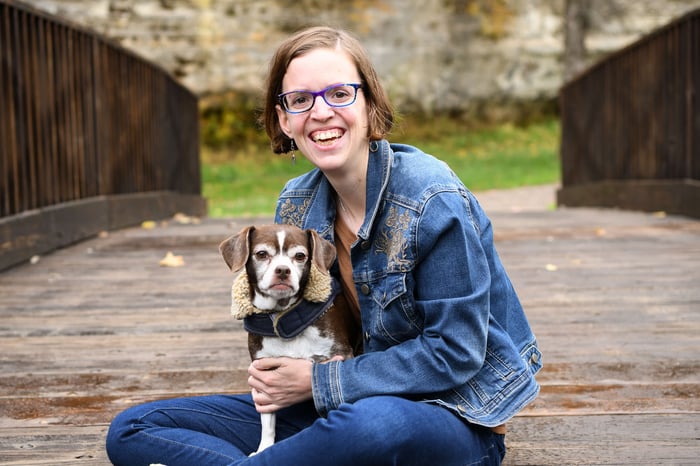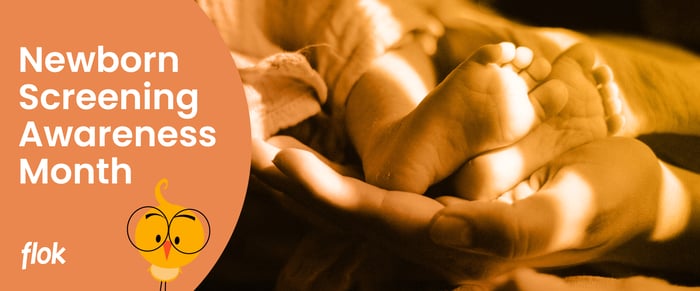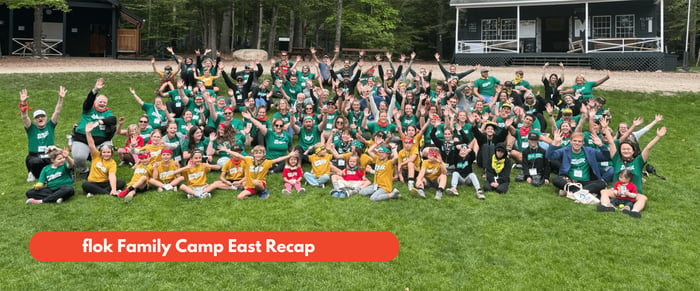Our “Meet the flok” series profiles the inherited conditions of protein metabolism that make up our diverse community: Classical Homocystinuria, Maple Syrup Urine Disease, Organic Acidemias, Phenylketonuria, Tyrosinemia, and Urea Cycle Disorders. Each article highlights personal stories of resilience and the efforts of advocacy leaders to support individuals facing each condition. We hope this series will educate, inspire, and unite our flok community in a shared mission to improve treatment for our rare conditions.
FAST FACTS: Glutaric Acidemia Type 2 |
| Cause The body cannot process proteins and fats to produce energy which creates a buildup of toxic acids in the blood, urine, and tissues |
| Prevalence No current data available |
| Incidence 1:200,000 births |
| Presenting Symptoms |
Muscular |
| Treatment A diet low in protein and fats and high in carbohydrates, frequent meals and snacks, and dietary supplements. Early and consistent treatment may prevent above symptoms. |
| Source: RareDiseases.org |
FAST FACTS: Propionic Acidemia |
Cause |
Prevalence |
Incidence |
Presenting Symptoms |
Muscular Central Nervous System Organic Function Metabolic |
Treatment |
| Source: MedlinePlus.gov |
Isa Batista
Glutaric Acidemia type 2
As a high school graduate about to start her first year of college, 19-year-old Isa Batista shares her excitement for what lies ahead. She also radiates the strength of someone who has faced significant challenges and persevered to reach this milestone. Isa opens about her experience growing up with Glutaric Acidemia type 2, an Organic Acidemia, and how it has shaped her into the person she is today.
A Rare Diagnosis
Isa was born in Framingham, Massachusetts in 2005 shortly after her parents emigrated from Brazil. A few days after her birth, she became fussy, tearful, and had difficulty breathing. Her parents returned to the local hospital, where doctors ran several tests. They discovered Isa’s blood was highly acidic – a marker of Organic Acidemia – and told her parents she might only have a few days to live. She was transferred to Boston Children’s Hospital where she underwent extensive testing, including a skin biopsy. The biopsy confirmed a diagnosis of an Organic Acidemia called Glutaric Acidemia type 2 (GA-2), a rare metabolic disorder. People with GA-2 cannot break down proteins and fats from food to produce energy. This causes an acidic buildup, called metabolic acidosis, which can cause poor feeding, vomiting, organ damage, and death if left untreated.
Dr. Edward Neilan, a geneticist and rare disease expert, diagnosed Isa. He told Isa’s family she was one of the first patients in Boston Children’s metabolic program with GA-2, and that while they had a treatment protocol for her rare condition, her prognosis was an unknown. Isa shares, “There was so much uncertainty. They didn’t know if I would ever speak, walk, or be able to live on my own. The doctors never had the answers because it was so rare.” They started treatment with an IV sugar solution and a low-protein, low-fat medical formula. Once Isa was stable, she returned home with her family and began a difficult journey adjusting to life with GA-2.
Navigating the Health Hurdles
Isa reflects on how isolating it must have been for her parents to navigate the early years of her diagnosis. Having recently moved from Brazil, they spoke Brazilian Portuguese and very little English. “They were only in the United States for a few months before they had me. They didn’t know anyone and had to deal with all of this in a foreign country and language.” She expresses gratitude for the kindness shown to her family by her pediatric physician, Dr. Lindaman, who learned Portuguese to better communicate with her parents and other immigrant families at their clinic.
 Around age three, Isa’s appetite declined and she had difficulty swallowing. Her clinic recommended placing a feeding tube for nutritional support – which she relied on until she was almost 12 years old. Every night her parents attached a bag of PediaSure to the feeding tube while she slept; consistent sugar intake provided Isa’s body with energy she couldn’t metabolize from protein and fats. When Isa started to receive more nutrition by mouth, she stuck to a low-protein and high-carbohydrate diet. Isa and her parents wrote down everything she consumed, following a strict schedule – “I drank juice every three hours on the dot because it has a lot of sugar.” Even though she closely followed her medical diet, Isa faced a daily battle with vomiting and exhaustion, often sleeping throughout an entire day.
Around age three, Isa’s appetite declined and she had difficulty swallowing. Her clinic recommended placing a feeding tube for nutritional support – which she relied on until she was almost 12 years old. Every night her parents attached a bag of PediaSure to the feeding tube while she slept; consistent sugar intake provided Isa’s body with energy she couldn’t metabolize from protein and fats. When Isa started to receive more nutrition by mouth, she stuck to a low-protein and high-carbohydrate diet. Isa and her parents wrote down everything she consumed, following a strict schedule – “I drank juice every three hours on the dot because it has a lot of sugar.” Even though she closely followed her medical diet, Isa faced a daily battle with vomiting and exhaustion, often sleeping throughout an entire day.
Isa was hospitalized between five to ten times a year with metabolic acidosis, with some hospitalizations lasting up to six weeks to stabilize her blood enzyme levels. After she was discharged, she would follow up within a few days for more tests and appointments. “I missed a lot of school and lessons. I’d receive a huge packet of all the work I needed to catch upon, and not have the energy to do it. To call it a challenge was an understatement” Isa says. She had a 504 plan in school that provided accommodations to support her low energy and dietary needs, but those accommodations brought other challenges.
Isa took frequent rest breaks during school activities and ate and drank more often than other students to maintain her energy. She remembers the remarks classmates made about her strength or speed, or questions they asked, like Why are you always eating? While Isa knew she needed to listen to her body and follow her treatment plan, she felt uncomfortable in school. The teachers’ strict monitoring of her diet made her anxious about eating in front of others. She says, “The whispers and stares lingered.”
When Isa reached preteen age, many of her GA-2 symptoms improved or went away completely. She stopped vomiting in the morning, regained energy, and had fewer metabolic acidosis episodes. She started swimming and dancing – “I felt so normal and strong, like I conquered it.” This lasted for a few years, until age 15 when Isa developed intense muscular pain throughout her body. She started experiencing severe pain with movement– whether she was brushing her hair or walking up a few stairs to her next class. Isa transitioned to virtual classes because the pain episodes became more unpredictable and unmanageable.
Isa’s muscular pain, called rhabdomyolysis, can occur with GA-2 and is treated with IV fluids and supplements. While the treatment reduces symptoms, it doesn’t eliminate them. She was referred to a chronic pain clinic and a therapist for added support. “I was depressed and anxious, and my therapist really helped me navigate my pain and the challenges it brings.” While Isa has a supportive care team to help manage her symptoms, she still endures pain and stays hopeful for advances in the research and treatment of GA-2.
Pursuing her Passions
The daily obstacles of GA-2 – including 15 different supplements, a specialized diet, and muscular pain – haven’t stopped Isa from doing what she loves. She sings in her church choir, provides interpreter services for the community, swims, paints, and works as a makeup artist. “I enjoy cooking – anything from Brazilian, American, to Italian foods!”
She was recently awarded an academic scholarship through flok’s Guthrie-Koch Fellowship program and will attend Lasell University this fall to study psychology and biology. She aims to become a psychologist or doctor serving metabolic patients, noting that her experience with GA-2 fostered empathy and a drive to support others with metabolic conditions – “I would love to work in the behavioral health department at Boston Children’s Hospital. Because I have this firsthand experience, I can relate to people in a way that most providers can’t.”
Isa hopes that by sharing her story about life with GA-2, she can inspire caregivers and others with an Organic Acidemia to be optimistic and forge ahead. She advises, “Hang in there. It's frustrating and heartbreaking at times, and it may seem like there is no light at the end of the tunnel. But these experiences help shape us into the people we are today."
Karli Harguth
Propionic Acidemia
Karli is a young adult living with Propionic Acidemia, a type of Organic Acidemia that affects her body’s ability to break down certain proteins and fats. Karli reflects on growing up with this rare condition, the support she received along the way, and how she became a passionate advocate for herself and others with disabilities.
Adjustment in Childhood
Karli was born in Minnesota in 1989 before the state included Propionic Acidemia (PA) on its Newborn Screening panel. It wasn’t until ten months of age that doctors confirmed her rare metabolic condition; only one other person in the state shared her diagnosis. With PA, the body cannot metabolize the amino acids isoleucine, methionine, threonine, and valine. This causes a buildup of acid in the blood that becomes ammonia. Ammonia has toxic effects on the brain that can cause seizures, brain damage, and even death if left untreated.
To manage her condition, Karli’s doctors recommended a lifelong low-protein diet and a medical formula free of the amino acids her body couldn’t metabolize. She was placed on a nasogastric tube for nutrition – common for young children with PA due to difficulty feeding. Karli relied on tube feeds until kindergarten, when a home nurse helped her transition to drinking the formula.
 Growing up, Karli had trouble keeping up physically with her siblings and classmates. “With my condition, I have low muscle tone and it took me ten times longer to do things than other kids, and I would feel really short of breath and fatigued.” When Karli’s family went biking or sledding, they brought a rope to pull her when she felt tired. “My parents never treated me differently than my brother and sister, and they always let me try new things and made adjustments.”
Growing up, Karli had trouble keeping up physically with her siblings and classmates. “With my condition, I have low muscle tone and it took me ten times longer to do things than other kids, and I would feel really short of breath and fatigued.” When Karli’s family went biking or sledding, they brought a rope to pull her when she felt tired. “My parents never treated me differently than my brother and sister, and they always let me try new things and made adjustments.”
Karli received accommodations in school for both learning and physical activities; she used a specialized chair in the classroom to support her posture and had tests read aloud to her by teachers in a quiet setting. During puberty, she began experiencing focal seizures in class – periods she describes as staring off into space and having memory gaps.
While Karli did well in school with support, she noticed stares from her classmates related to her medical needs. Even though she felt like an outsider at times, she embraced what made her unique and joined her school’s Diversity Club. Her self-advocacy would later become a significant part of Karli’s life and career.
Championing Rights: Self-Advocacy
Through attending virtual events hosted by the Organic Acidemia Association and connecting with others in the PA community, Karli learned the physical and intellectual impairments caused by the condition vary widely. She says, “There’s no universal experience for PA, everyone has different capabilities, and you have to try things and learn from your own experiences.” While it’s not uncommon to need group home support with a diagnosis of PA, Karli craved more independence. After working a few different jobs in her adulthood, she knew she could live alone and felt ready to take the step.
In 2009, Karli and her parents contacted the Arc Minnesota, an organization that offers supportive services for individuals with disabilities and their families. The Arc helped her find her own apartment near her parents' home and set up services to support her independence. Several years later, Karli began working at Arc as a Self-Advocacy Associate. In her role, Karli serves as a voice and mentor for others with disabilities; she hosts events, creates workshops, and develops tools to help people stand up for their rights – “It’s my dream job,” she beams.
Karli plans to expand Arc’s self-advocacy programming to middle school and high school students with disabilities to help them navigate bullying and prepare for college or a first job. “I want to help them build confidence so they say, ‘Ok, I can do this.’”
And Karli is doing it. She now lives in an apartment an hour away from her family, continues to work at the Arc, and manages her metabolic condition on her own. She uses a pillbox to organize different vitamins and supplements, drinks her medical formula twice a day, and tracks the amount of protein she eats daily. Karli also snacks often to keep her amino acid and ammonia levels stable – “I always carry an Ensure in my purse to get a boost if I’m tired.”
Karli’s journey is an inspiration for others who live with PA and similar metabolic disorders. While she still faces daily challenges with strict dietary management, fatigue, and risk of seizures, she leads a successful and happy life. Outside of her job, Karli volunteers for youth ministry, leads an active social life, walks her dog Lady Pugglesworth, and sews quilts for friends. She also embraces her role as “Auntie” to her niece and nephew and hopes to one day build her own family.
For those navigating a diagnosis of PA, Karli urges, “No matter the setbacks, keep following your dreams.”
Organizations that support those with Organic Acidemias can visit our partnership page at flok.org/partners.



